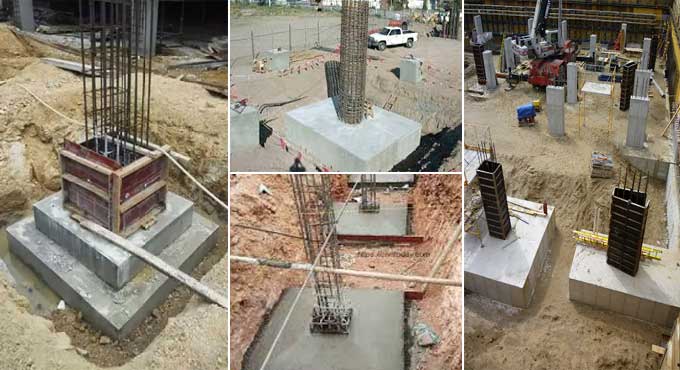
Types of Spread Foundation | Advantages and Disadvantages of Spread Footing
The spread foundation is a type of foundation that transmits the load from the structure, like a column, and disperses it to support the soil. Several types of rock blocks, bricks, and reinforced concrete have use for the spread footings.
The use of reinforced spread footings with dramatically lower dimensions has led to the avoidance of such types of massive foundations.
Furthermore, concrete sections are now more usable due to reinforced concrete sections. Solid and flexible spread foundations can be classified according to their stiffness. Defining deformation and strain distribution at the soil-foundation contact is determined by the soil stiffness and foundation elasticity.
Types of Spread Foundation
- Raft or Mat Foundation
- Isolated Footing or Column Footing
- Combined Footing
- Strap or Cantilever Footing
- Continuous Footing
- Inverted Arch Footing
- Grillage Footing
- Wall Footing
Raft or Mat Foundation
Raft foundations support the walls and columns beneath a structure by covering the entire area underneath.
RCC slabs with or without beams of appropriate thickness with appropriate reinforcements use as the foundation. Walls and columns construct over this.
Isolated or Column Footing
They support columns. A stepped type can construct, or a concrete base can have projections. A concrete bed that is heavily loaded with columns reinforced in both directions with a steel rod.
For concrete beds, 15 cm of offset is usually provided on all sides. Brick masonry columns provide a 5 cm offset on all four sides. There are 3 types of footings for concrete columns:
- Slab footing
- Stepped footing
- Sloped footing
Combined Footing
A combined footing permits more than one column to support in a row. Combining two columns may yield a rectangular footing if the columns carry equal loads, or a trapezoidal footing if there are space limitations or the columns carry unequal loads.
Strap or Cantilever Footing
In strap footings, a beam-like beam connects many individual footings. The cantilever foundation is also referred to as a pump handle foundation.
Continuous Footing
The concrete slab covering this structure extends over more than two columns. The centroid of the footing in the plan must be traversed by the resultant of the column loads. There are many benefits to using this type of foundation, including preventing differential settlements in earthquake zones.
Inverted Arch Footing
Unlike other types of foundations, inverted arch footings are very uncommon. There may not be sufficient bearing capacity of the soil, and the structural load of the structure is concentrated on the walls, making deep excavations impossible.
This type of foundation is used in such situations. There are arches constructed between the base's two walls. The walls must have adequate thickness and strength to withstand the thrust outward caused by the arching action.
Grillage Footing
A grillage footing transmits heavy loads from a steel column to low-density soils. In this way, no deep excavations are required, and the pressure at the base reduces.
The grillage footing consists of steel beams provided in one or two tiers that weld together. It is usual to arrange a double tier so that the top tier is perpendicular to the bottom tier.
Wall Footing
Wall footings can either be simple or steeped. Stepped footings carry heavy loads, while simple footings support light loads. Stepped footings have several projections on either side of the wall as opposed to simple footings with only one projection.
Conclusion
There are various types of shallow foundations, including the spread foundation. It is common for building contractors to use the Spread foundation. Structures supported by a large or wide base. A spread foundation may be a wall footing, an isolated footing, a combined footing, a strap footing, a continuous footing, an inverted arch footing, a grillage footing, or a raft foundation.


